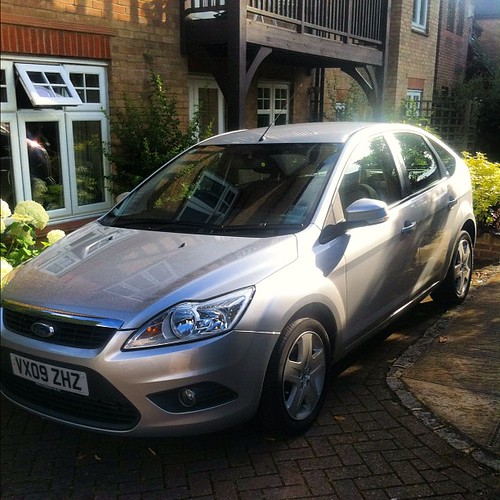First, let’s clear something up – it’s not the wrong side of the road. In fact, some would adamantly state it’s the correct side, and the other 70% of the world is wrong! But it is the other side of the road, and driving on it is the least confusing part of this whole process, if you’d believe it.
For anyone coming from North America, I highly advise getting comfortable driving a manual transmission BEFORE you head to the UK. Because thinking about everything else that’s new, and then trying to change gears without stalling or running into anything, is enough to make one’s brain explode. Even if you got a great deal for Van Insurance from £149, or what have you, practice, you will thank me!
So far I haven’t hit anything, but I have stalled. A lot. Though at least the prevalence of manual transmission cars here means drivers generally expect other cars (especially the ones with gigantic “L” stickers on them) to stall somewhat frequently.
The other nice thing about the traffic rules and patterns here is that they’re generally designed to keep traffic moving as much as possible. I have yet to see a stop sign. The rule at unmarked intersections (which are very common) is to “give way” (yield) to traffic on the right, or on the major road, and most major intersections are controlled by roundabouts rather than perpendicular stoplights.
But man, roundabouts? They are nerve-wracking. Especially for someone not particularly confident in their clutching skills. (I was going to say “they’ll be the death of me” – but I’m not confident enough to even joke about that yet.) In my nightmares I see a wee gap in traffic, think I can go, start to move off, and then I stall, and I’ve bunny-hopped into the middle lanes of a roundabout, and I’m blocking traffic and I get plowed-down by a double-decker bus.
Needless to say, the few times I’ve driven without the instructor I’ve planned my routes around lots of left turns and as much roundabout avoidance as I can find. Hopefully after a few more lessons, and some more practice in light traffic I’ll be feeling more confident.
And, somewhat related to driving, the transport of the tiny human in our car has been interesting as well.
Our Canadian car seat is, of course, not approved for use in the UK/EU. I was (and still am, really) convinced this is a total racket; just as US car seats aren’t approved for use in Canada (or elsewhere in the world), and Canadian seats also aren’t approved for use in the US. I can’t believe crash data is so drastically different across continents that the device would implode upon itself in a crash if it somehow realized it wasn’t in its home country.
Better safe than sorry (at least, insurance-wise when we had to compare auto insurance quotes at the dealership), so we did replace the car seat. And I have to say, because ISOFIX came in as a standard in the UK only fairly recently, seats here are FAR better designed to be installed with a seatbelt than anything I’ve seen in Canada. No belt-locking clips to fuss with, and multiple guides and tension-points. Our UK seat (the MaxiCosi Tobi) fits far better in our car here than the Canadian one did. In fact, stores and manufacturers here provide a lot of guidance on which seats work best in which cars. It also makes me feel a lot better about putting Isaac in a forward-facing car seat now (In Canada, Isaac’s recommended to remain rear-facing for another 6-8 months).
But I don’t think I’ll ever get used to seeing so many car seats in the front seats of cars. Even when I was smaller (and out of a booster seat), I remember the rules being very obvious about no carseats or booster seats in the front, and even after that, “the back seat is the safest place for a child.” And this is long before airbags came into the picture. Now, it’s part of the driving theory test in the UK to learn that “before you put your childseat in the front seat, you need to remember to turn off the front passenger airbag.” Seriously?
I’m trying not to be a typical ExPat who attempts to recreate as much of their home-country experience as possible when abroad, but in this case, I’m keeping my kid in the back seat. Especially since the back passenger side of the car is furthest away from the buses I’m convinced are going to hit me in the roundabouts.



Once you get the hang of roundabouts, you’ll come to appreciate them. They are, in many cases, vastly superior (and cheaper, I imagine) to traffic lights.
I already appreciate the efficiency of the roundabouts. I’m just terrified to drive in them so far. Especially when they have multiple lanes I need to change through (while not stalling or hitting anything/one). Though I’ve heard the French ones can be tricky, where traffic entering (rather than traffic already in) the circle has right of way? Or is that something unique to L’Etoile roundabout?
Adapting to driving on the left is easy. You won’t know panic until you try to adjust back to the right side in Canada. 🙂
I’m with you on the racket that is car seats (from a distance, of course) especially the “expiry date” on them. Srsly? WTF! AND I’m 100% with Darren on roundabouts. they’re awesome and keep traffic moving… adjusting to a “pedestrian scramble” on the other hand, looks menacing. 🙂 http://www.youtube.com/watch?v=psDkHECGVhk
Yah, apparently the plastic “can degrade over time” and become less safe. And yet the airplane built in 1983 that’s now held together with spit and duct tape is doing just fine.